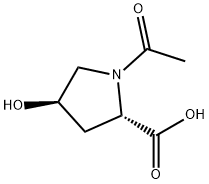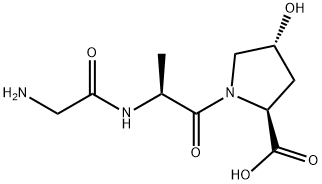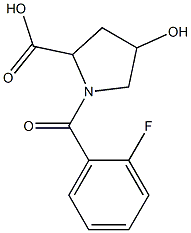Oxaceprol
Synonym(s):N-Acetyl-L -hydroxyproline
- CAS NO.:33996-33-7
- Empirical Formula: C7H11NO4
- Molecular Weight: 173.17
- MDL number: MFCD00037339
- EINECS: 251-780-6
- SAFETY DATA SHEET (SDS)
- Update Date: 2024-12-18 14:07:02

What is Oxaceprol?
Chemical properties
White powder
Originator
Jonctum,Merrell,France,1970
The Uses of Oxaceprol
trans-1-Acetyl-4-hydroxy-L-proline can be used:
- In the stereospecific synthesis of 4-fluoroglutamic acid.
- To synthesize molecular targets for von Hippel-Lindau (VHL) E3 ubiquitin ligase.
- As a precursor to synthesize pseudopoly(amino acids) such as poly(trans-4-hydroxy-4-acyl-L-proline ester) and a biodegradable polymer, poly(lactic acid-glycolic acid-4-hydroxyproline).
Manufacturing Process
16.7 g (0.127 mol) of L-hydroxyproline are dissolved in 400 ml of pure boiling acetic acid. With vigorous boiling and agitation, a mixture of 13.7 ml (0.154 mol) of rectified acetic anhydride and 250 ml of pure acetic acid is added during 25 minutes. Without discontinuing the stirring, contents of the flask are cooled by simply causing fresh air to circulate externally round the flask until the temperature of the mixture is reduced to about 35°C. The acetic acid is removed by using a rotary evaporator without exceeding 35°C under a vacuum of about 15 mm Hg. After one hour, 20 ml of anhydrous toluene are added, then 10 ml of anhydrous acetone; the mixture is homogenized and concentrated again as above during 30 minutes. Then 25 ml of acetone are added again, and subsequently 20 ml of toluene, the product being concentrated again; gradually the solution is converted into an amber-colored crystallized paste. Finally, 30 ml of acetone are added to the residue, and stirring is carried out until the oily fraction surrounding the crystals is dissolved. The product is then cooled in an ice chamber, centrifuged, washed with anhydrous acetone and eventually dried, After recrystallization from acetone, crystals are obtained, melting point 132°C.
Therapeutic Function
Antirheumatic
Flammability and Explosibility
Not classified
Properties of Oxaceprol
| Melting point: | 132-133 °C (dec.)(lit.) |
| Boiling point: | 303.8°C (rough estimate) |
| alpha | -119 º (c=4 in H2O) |
| Density | 1.3346 (rough estimate) |
| vapor pressure | 0Pa at 20℃ |
| refractive index | 1.4490 (estimate) |
| storage temp. | Sealed in dry,2-8°C |
| solubility | DMSO : ≥ 32 mg/mL (184.79 mM) |
| pka | 3.48±0.40(Predicted) |
| form | Crystalline Powder |
| color | White |
| optical activity | [α]20/D 119°, c = 4 in H2O |
| Merck | 14,6903 |
| BRN | 84043 |
| CAS DataBase Reference | 33996-33-7(CAS DataBase Reference) |
| EPA Substance Registry System | L-Proline, 1-acetyl-4-hydroxy-, (4R)- (33996-33-7) |
Safety information for Oxaceprol
| Signal word | Danger |
| Pictogram(s) |
 Corrosion Corrosives GHS05 |
| GHS Hazard Statements |
H318:Serious eye damage/eye irritation |
| Precautionary Statement Codes |
P280:Wear protective gloves/protective clothing/eye protection/face protection. P305+P351+P338:IF IN EYES: Rinse cautiously with water for several minutes. Remove contact lenses, if present and easy to do. Continuerinsing. |
Computed Descriptors for Oxaceprol
| InChIKey | BAPRUDZDYCKSOQ-RITPCOANSA-N |
Oxaceprol manufacturer
New Products
(S)-3-Aminobutanenitrile hydrochloride 4-Methylphenylacetic acid N-Boc-D-alaninol N-BOC-D/L-ALANINOL Tert-butyl bis(2-chloroethyl)carbamate 3-Morpholino-1-(4-nitrophenyl)-5,6-dihydropyridin- 2(1H)-one Furan-2,5-Dicarboxylic Acid Tropic acid 1-Bromo-3,5-Di-Tert-Butylbenzene S-2-CHLORO PROPIONIC ACID ETHYL ISOCYANOACETATE 2-Bromo-1,3-Bis(Dimethylamino)Trimethinium Hexafluorophosphate 4-IODO BENZOIC ACID 3-NITRO-2-METHYL ANILINE 1-(2,4-DICHLOROPHENYL) ETHANAMINE (2-Hydroxyphenyl)acetonitrile 4-Bromopyrazole 2-(Cyanocyclohexyl)acetic acid 4-methoxy-3,5-dinitropyridine 1-(4-(aminomethyl)benzyl)urea hydrochloride 2-aminopropyl benzoate hydrochloride diethyl 2-(2-((tertbutoxycarbonyl)amino) ethyl)malonate tert-butyl 4- (ureidomethyl)benzylcarbamate Ethyl-2-chloro((4-methoxyphenyl)hydrazono)acetateRelated products of tetrahydrofuran




![(2S,4R)-1-[[3-[(4,6-DIMETHOXYPYRIMIDIN-2-YL)OXY]PYRIDIN-2-YL]CARBONYL]-4-HYDROXYPYRROLIDINE-2-CARBOXYLIC ACID, ETHYL ESTER](https://img.chemicalbook.in/StructureFile/ChemBookStructure21/GIF/CB4799182.gif)



You may like
-
 33996-33-7 Oxaceprol 99%View Details
33996-33-7 Oxaceprol 99%View Details
33996-33-7 -
 33996-33-7 98%View Details
33996-33-7 98%View Details
33996-33-7 -
 N-Acetyl-L-hydroxyproline 98.00% CAS 33996-33-7View Details
N-Acetyl-L-hydroxyproline 98.00% CAS 33996-33-7View Details
33996-33-7 -
 trans-1-Acetyl-4-hydroxy-L-proline CAS 33996-33-7View Details
trans-1-Acetyl-4-hydroxy-L-proline CAS 33996-33-7View Details
33996-33-7 -
 1975-50-4 98%View Details
1975-50-4 98%View Details
1975-50-4 -
 2-HYDROXY BENZYL ALCOHOL 98%View Details
2-HYDROXY BENZYL ALCOHOL 98%View Details
90-01-7 -
 14714-50-2 (2-Hydroxyphenyl)acetonitrile 98+View Details
14714-50-2 (2-Hydroxyphenyl)acetonitrile 98+View Details
14714-50-2 -
 118753-70-1 98+View Details
118753-70-1 98+View Details
118753-70-1